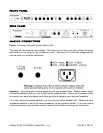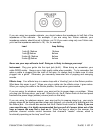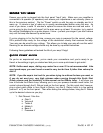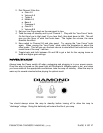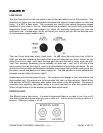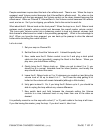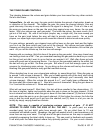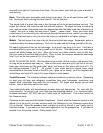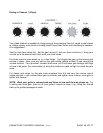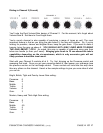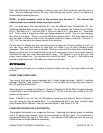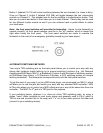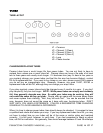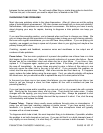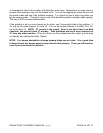PHANTOM OWNER’S MANUAL (rev.2) PAGE 15 OF 17
between the two outside tubes. You will need a Bias King or similar bias probe to check this.
The bias trim pot, in the event you need to adjust bias, is located on the PCB.
DIAGNOSING TUBE PROBLEMS
Most tube amp problems relate to the tubes themselves. After all, tubes are not the cutting
edge of technological advancement. DA tube choices are based both on tone and reliability.
Nevertheless, tube problems are not infrequent occurrences. But before you have to worry
about shipping your amp for repairs, learning to diagnose a tube problem can keep you
rockin’.
If you read the preceding section, you’ve learned when and how to change your tubes. We
can not stress enough the importance of changing tubes to keep your amp running optimally.
But even with regular maintenance, you can still have tube problems. If you are playing out
regularly, we suggest you keep a spare set of power tubes in your gig bag and maybe a few
preamp tubes just in case.
Crackling, squeals and feedback, excessive noise and muddiness or low output are all
evidence of tube problems.
Power tubes. The two main symptoms of a power tube problem are a blown fuse or a tube
that begins to glow cherry red. Either are typically indicative of a power tube failure. Some
failures can be an intermittent short and some can be a tube failure. If you blow a fuse,
replace it. If it happens again, replace your power tubes. If the tube glows cherry red, shut
the amp off immediately. As power tubes are wired in pairs, a failure of this nature in one
tube can cause the other tube in the pair to fail with it. If you encounter this problem, as
noted, shut the amp down immediately. Wait a few minutes and fire it back up. If it happens
again, replace the tubes before using the amp again. If not, you should probably still replace
the tubes soon, but you should be able to operate the amp for a short period of time.
In the event you have one or two power tube failures, you can replace that one tube or two
tubes to get you through a show, but then replace all four with a matched set (see the
preceding section).
If you are hearing noise and/or crackling, you can rule out (or in) a power tube with a simple
test. Gently tap on the power tubes, one at a time. They should not make noise. If noise
changes with the tapping, you may have a failing power tube. Always be prepared to shut
the amp off in case you have a failing tube and the tap causes it to short. If so, shut the amp
off immediately and replace the tubes.
Preamp Tubes. Preamp tubes usually cause problems through noise or microphonics. If
noise, you will hear hiss, crackling, popping or similar issues. If you hear squeal, hum or
feedback, it is typically a microphonic tube. Noise from microphonic tubes will typically
increase with a volume increase.
To diagnose which tube is bad, the most important thing is to determine, if possible, whether
the problem is on both channels or just one. If you can tell that it is in both channels (even if
only slightly on one channel), it is most likely V1, which is common to both channels. A noisy



